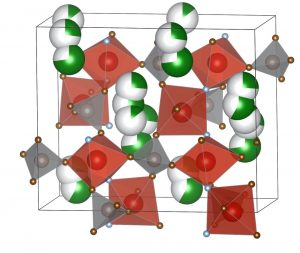Press Release: Titanium-containing electrodes for sustainable batteries

SNAPSHOT
- A new titanium-based positive electrode was developed;
- The record-breaking electrode potential of 3.6 V was measured in a potassium-ion battery;
- The combination of all the features might be well suited for high-power and large-scale applications such as electric vehicles.
BRIEF
(Trieste, Italy) A research article published in Nature Communications on the 20th of March 2020 reported the record-breaking potential of 3.6 V for a titanium-based positive electrode in a potassium-ion battery. The work was jointly led by Prof. Evgeny Antipov, from Lomonosov Moscow State University, and Prof. Artem Abakumov, from the Skolkovo Institute of Science and Technology (Skoltech). Experimental results were obtained with the contribution of CERIC-ERIC and its Italian partner facility, Elettra – Sincrotrone Trieste. This work provides a new playground to design sustainable titanium-containing positive electrode materials.
BACKGROUND & DETAILS
Lithium batteries “enabled the mobile world” as said by Prof. Olof Ramström, a member of the Nobel Committee that awarded the development of lithium-ion batteries in 2019. However, the mass diffusion of batteries requires new technologies that go beyond the current cobalt- and lithium-based technology. Those two elements are, in fact, rare, expensive, and located in few geographical areas, thus resulting in high and unstable prices.
In this regard, potassium-ion batteries are among the prime candidates since are based on cheaper and readily available elements, like potassium in place of lithium. At the same time, cobalt can be replaced by iron, manganese, or titanium, as suggested in the present work. In this research, the authors proposed a new electrode made of KTiPO4F. Its peculiar crystal structure accounted for a record-breaking potential of 3.6 V, thus solving the low potential issue that affected the titanium-based electrodes.
A variety of experiments allowed scientists to define the properties of this battery. Among them, operando X-ray diffraction (XRD), performed at the CERIC Italian Partner Facility: Elettra- Sincrotrone Trieste. In particular, a fundamental contribution was given by Dr. Jasper Plaisier, head of the MCX beamline, and Dr. Mattia Gaboardi, who assisted in the experiment and in the data processing. X-ray diffraction experiments allowed to follow the structural changes occurring inside the electrode material during battery operations. CERIC user, Prof. Stanislav Fedotov from Skoltech, was granted open access to this technique, which is commonly used to identify the atomic and molecular structure of materials.
QUOTE
Prof. Stanislav Fedotov, Skoltech (Corresponding Author): “This is an outstanding result because it can shift the entrenched paradigm of perceiving titanium as an “only-anodic” metal in battery community. We believe that the discovery of this material might give a fresh impetus to look for other titanium-containing positive electrodes with attractive electrochemical performance.”
CERIC-ERIC is a unique integrated multidisciplinary and multi-technique European distributed Research Infrastructure Consortium, operating mainly in Central Europe. It provides free, merit-based access to analytical and modification techniques based on synchrotron light and other microscopic probes for nano-level Science and Technology.
- Picture (JPEG): Corresponding charge-discharge profile_High/Mid Resolution
- Picture (JPEG): In operando diffraction studies of KTiPO4F _High/Mid Resolution
- Picture (JPEG): KTiPO4F crystal structure_ High/Mid Resolution
- PDF: Press release (ENG/ITA)
- PDF: Original Publication
- PDF: CERIC-ERIC general description (ENG)
CONTACTS
CERIC-ERIC Press Office: press@ceric-eric.eu
-
30.06.2025
CERIC Newsletter | June 2025
-
30.06.2025
The CERIC 2024 Report is online



